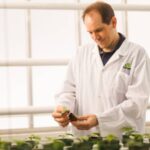Duets: Peat industry confusion
Joining me to discuss peat moss is James Altland, research leader for the Application Technology Unit of the USDA Agricultural Research Service in Wooster, Ohio.
James earned his undergraduate degree in 1995 at Penn State University in horticulture. His graduate education was completed in 2002 at Auburn University in plant nutrition. He spent the first five years of his career as a faculty member in Oregon State University’s Department of Horticulture. His career with the USDA began in 2007 where he supervises a team of 11 scientists and 25 support staff.
Peter: Thank you for taking time to join me, James. Let’s start with your decision to focus on peat moss as a substrate component. I heard you speak at a 2023 workshop where you presented a view of the peat industry that is more optimistic than what we hear routinely. Tell us about your USDA program.
James: My research program focuses on container substrates and how they affect plant growth. I started working with substrates at Oregon State University, focusing primarily on chemical and physical properties. Recently, I started studying the biological properties, including how the microbiome specific to these substrates affects plant health.
New post doctoral research will study how substrates decompose in containers. Once we understand the mechanisms of decomposition more thoroughly and quantitatively, we will try to link that to the microbiome to understand how those two properties are related. Finally, I have recently taken an interest in substrate sustainability. The use and sustainability of peat in North America is of particular interest to me.
Peter: The evolution of your work mirrors a project I’ve been working on for 10 years. I’ve been researching biological water management — algae and biofilm control. Part of the challenge is learning what we don’t understand in order to successfully apply what we do. I’m sure exploring the biological realm and connecting that to the microbiome is exciting. Let’s talk about your work with peat specifically.
James: I’ve been working with peat since I started working on substrates 20 years ago. While most of it has been conducted on barkbased substrates for outdoor grown nursery crops, peat as an important component of nursery substrates has always been a necessary and integral part of that research.
I began talking about the sustainability of peat. We’ve all heard the rumblings about banning or limiting peat use in Europe over sustainability issues. Much of this attention in Europe was due to our understanding that peat bogs are important global carbon sinks, greatly impact atmospheric carbon levels and thus global warming. That, coupled with the level of peat bog degradation in Europe, made them easy targets for regulations and outright banning.
That sentiment has recently migrated across the pond to the U.S. In North America, almost all the peat comes from Canada and is exported and used in the U.S. There are 294 million acres of peatlands in Canada. That’s almost three times the land area of California. Of that area, approximately 43,500 acres are currently used for peat extraction (with another 34,500 acres having been harvested in the past) which, to carry the analogy further, could fit within Fresno City limits. Only about 0.03% of the peatlands in Canada are or ever have been used for horticultural peat.
There is concern that opening peat bogs for peat extraction will result in CO2 loss to the atmosphere, making global warming even worse. Research by Hongxing He at McGill University measured CO2 loss from these bogs at 1.5 tons of CO2 per hectare per year. To put these numbers into perspective, a single flight on a private jet from Dallas to Chicago releases over 4 tons of CO2 into the atmosphere. That single flight emits two to three times the amount of CO2 than a hectare of exposed peatlands over the course of a year.
Peter: As with many global issues, some find it desirable to fit as much as possible into a single silo to make arguing one way or the other compelling. I think you’re saying that whatever Europe is experiencing with its peat industry doesn’t necessarily translate to North America. Am I correct?
James: That’s correct, Peter. Widespread agriculture and industrialization of Europe is centuries older than North America which has led to more widespread use (and degradation) of peatlands there.
There are alternatives to peat, but can have similar or worse environmental impacts. Life cycle assessments (LCAs) are quantitative tools for understanding the impact of a product/service on the environment, human health and society. These analyses consider the carbon, and other inputs, from cradle to grave for the product/service in question.
LCAs from Europe have shown that peat alternatives, namely coir, have greater global warming, environmental and human health impacts than peat. Switching to these alternatives would do greater harm to the environment, not less.
Compared to other substrates or methods for growing plants, peat is sustainable! But is it still necessary to harvest peat despite its minimal impact on the environment? Yes, I believe it is.
Peat is used for commercial food production, growing tree seedlings for reforestation, and for propagation and production of ornamental crops used to beautify our urban environments. Peat isn’t being used to fuel luxury cars. It feeds the world, reforests the world and beautifies the world.
Peat is sustainable and it is necessary.
Peter: Thank you for painting a complete picture, James, the life cycle assessment aspect is an important level of insight. It has me thinking that the peat industry would benefit from a campaign like “Got Milk” and “The Incredible, Edible Egg” to get its message out.
A separate challenge with peat is its annual harvest yield. Whenever a wet summer results in a short peat harvest, it feels like the sky is falling. I believe this part of peat is being conveniently but unfairly lumped into the global sustainability issue to make the argument against it more compelling. This confuses growers and consumers creating more negativity.
James: These are two very different issues. There are currently no regulations in North America that are limiting peat harvest or its availability in the U.S. like we see in Europe. The limited availability of peat over the past few years is due to wet summers limiting the amount of peat that can be harvested. I’m not sure if the sky is falling. I’ve read articles in professional magazines suggesting that seven out of the past 10 years have had below average peat harvests due to weather. Is this a fluke or a new and persistent weather pattern? We don’t know yet.
Staving off environmental misinformation is one challenge facing the peat industry. Figuring out how to harvest peat with increasingly wet summers is another challenge. To be clear, these are two different issues stemming from two different causes.
Peter: Tell us about your research on improving the design and physics of the root zone profile.
James: I’m working with a team of scientists throughout the U.S. on a concept called substrate stratification. Instead of filling a container with the same substrate, we fill it with layers (or strata) of different substrates that each serve a function.
One successful strategy involves placing a coarse substrate (such as pine bark) in the lower 50% of the container with a finer premium substrate in the top 50%. This strategy redistributes water so that it’s more available to the recently potted liner at the top of the container and reduces oversaturation of the substrate at the bottom of the container. Jeb Fields at Louisiana State University showed that young liners establish more quickly and experience less water stress with this form of stratification. This also dramatically reduces cost by replacing half of the premium substrate with a lower cost pine bark.
If you are stratifying a container, it also makes more sense to put all the fertilizer in the top half. Jim Owen (USDA-ARS) showed that this strategy can reduce fertilizer costs by 20% and still produce a larger plant more quickly than incorporating the fertilizer, or topdressing, on the container surface.
These are just two examples of how stratification can save money and improve crop growth. Other strategies have been used to reduce weed growth in nursery containers, reduce phosphorus leaching and reduce drought stress.
When you open your mind to the possibility of using layers of substrates, as opposed to filling the entire container with just one uniform substrate, you open the door to unlimited possibilities in solving problems in the container. In my opinion, this concept is the biggest leap in substrate management we’ve seen in decades.
Peter: Thanks for sharing your insights to help growers unravel the confusion associated with peat’s different challenges and your exciting research results.


 Video Library
Video Library 



















